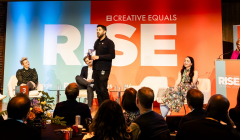
Are we leaving men and boys behind?
At Creative Equal’s RISE event, industry leaders consider how to reframe boys and men in marketing

When people have to make do with less, brands need to make changes.

With inflation rising to its highest rate for 30 years and energy bills spiralling, people across the country are having to make do with less. It is a social emergency that has significant implications for brands and businesses alike.
From the moral imperative of the living wage; to the challenges and marketing knowledge necessary to deliver in new ways.
The UK population is now more worried about their finances than catching Covid, according to research from University College London. Brands are already responding; Marks & Spencers has moved to reduce the cost of its everyday essentials range with new lower prices around its ‘Remarksable’ range.
Money saving expert Martin Lewis has said that the government should do more to ensure that people can heat their homes and have enough food, warning that Civil unrest ‘isn’t far away’. These challenges will affect consumers in different ways and the volatility of energy prices continue to take a toll
The rise in household bills, food and fuel bills has started to affect customer spending patterns. The British Retail Consortium revealed last month that consumer confidence is shaken; with expectations of people’s personal finances over the next 12 months reaching depths not seen since the 2008 financial crisis.
This is a challenge which is only set to rise up the consumer agenda, with this in mind we asked a selection of industry experts if brands should do more to address the cost of living crisis.

The answer is, as is usually the case, yes and no. Right now, people aren’t just concerned about how much spare cash they will have in their pockets, they’re fearful about whether they’ll have enough to pay their mortgage, feed their kids and heat their homes. However, brands should be cautious of making knee jerk reactions and remember their long term strategy.
Good brands will be those that address these societal and economic changes authentically and consistently to add value to the lives of their consumers when they need it most. For brands in a high frequency, low-value category, they need to recognise the role they play in helping customers survive and react to changes in available cash. But this responsibility shouldn’t be brought to life through promotions and short-term discounts as these tactics aren’t sustainable. Yes, they stem short-term loss of sales to a competitor but when prices inevitably rise again, they’ll not only have made less money in the discounted period, but they’ll also probably lose the customer as they look for more sustainable ways to balance the books. Instead, brands need to invest in longer-term strategies that help customers deal with changes in circumstance over time- think investing in, and expanding, your value range of products, for example.
For brands in high-value categories, they need to justify the cost of their products by ensuring customers value them and their role in their daily lives. In this environment, you double down on experience and quality and make sure your product is something your customers can’t imagine living without. For example, if you’re Apple, it’s about pointing customers in the direction of your utilities and services that can help them budget.
There is no one way to navigate through these challenging times. But by showing empathy and understanding and embedding this into a long-term strategy that can guide the business via its purpose, brands will nurture long-term relationships with their customers that go beyond the current crisis.

We’ve experienced such a litany of shocks since 2016 that the cost-of-living crisis might be considered just another short-term issue. But it will have profound effects not experienced for a generation. We already see a decline in consumer confidence, and discretionary spending will fall by nearly 20% for least affluent households this year.
Pre-crisis around 15% of the UK population were classed as fuel poor. As fuel bills will probably treble, we expect that at least a third of the population could be severely affected. This will be deeply felt, especially in the autumn when the next energy cap is announced, and we head into winter.
Brands will not be able to avoid addressing the cost-of-living crisis. Consumer response is likely to be immediate, affecting all discretionary spending. Brands that rely on seasonal spending (like holidays) or subscribers (TV platforms) will be squeezed. Add this to supply chain issues hitting the grocery sector, and we’ll see a major shift in how people shop.
Growth brands don’t have a choice but to adapt. There’ll be a surge in discounting to engage consumers. A consequence of this will be diminished loyalty. People will shop around. We expect brands to focus on retaining customers with offers to reduce switching. Non-essential expenditure is going to decline. Any brand in this space will have to fight hard for share.
It’s going to be tough for everyone and not short term. It will have a profound impact that brands can’t ignore. Smart brands will be the ones that recognise the issue early and adapt fast.
The cost-of-living crisis is becoming the foundation for a number of political battles across Europe. With pockets and wallets being squeezed, good brand marketers have to stay close to what’s on the minds of the people they serve, and make reasonable adjustments to stay competitive.
In our work on diversity & inclusion, we often speak to marketers who want a deeper understanding of class and socio-economic status and how it intersects with characteristics such as race and ethnicity. Steve Lacey, a stalwart of market research and founder of The Outsiders, taught me that marketers are obsessed with ABC1, and while increasing prices are going to affect this demographic, the real impact of this crisis is going to be felt amongst those of a lower socio-economic status. The data shows that people from Bangladeshi and Pakistani ethnic groups are twice as likely to be in the bottom fifth of incomes than average, closely followed by people from a Black ethnic group.
Brands might be rushing to show different skin tones in their adverts and pushing for more ‘diversity’ at the moment, but they need to be cognisant of the economic reality for the groups they are now showing and targeting. True representation goes beyond a superficial casting exercise and goes deeper into real experiences and understanding. Marketers and agencies need to build their cultural confidence to understand the nuances of modern society if they stand a chance of remaining relevant during these testing times.
Looks like you need to create a Creativebrief account to perform this action.
Create account Sign inLooks like you need to create a Creativebrief account to perform this action.
Create account Sign in